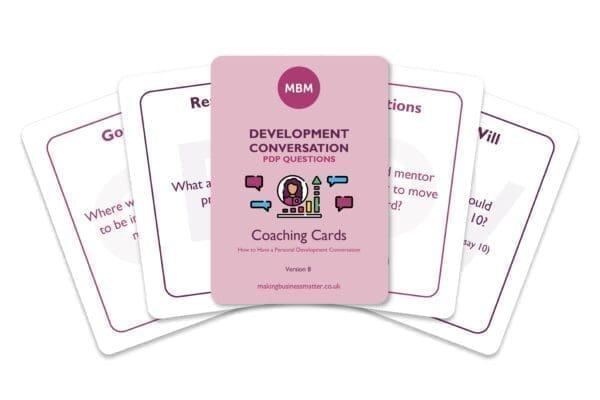Learn About the Situation, Behaviour and Impact Model and How to Use it Effectively
What is the SBI model?
Developed by the Centre for Creative Leadership, the SBI Model, or SBI Feedback Tool as it is sometimes known, outlines a simple structure, Situation – Behaviour – Impact, that you can use to give behavioural feedback.
When you structure feedback in this way, your people will understand precisely what you are commenting on, and why. And when you outline the impact of their behaviour on others, you’re giving them the chance to reflect on their actions and think about what they need to do next time. The same, or something different.
The tool also helps you avoid making assumptions that could upset the other person and damage your relationship with them.
One of the biggest advantages that this feedback model tool has over the other tools such as BOOST, idea, Hear, or Peer, is that SBI focuses on the impact with ‘I’ – Impact feedback.
Too often feedback has been given like, ‘That’s great, thank you.’ As a people manager saying thank you is good. It is even better if you say why. For example, ‘That’s great, thank you. It was good because the client loved it and will place another order.’ If you tell people what they do well, they will do more of it.
Article Overview:
- What are the elements of the SBI model?
- Next Steps Using this Feedback Framework
- Critique and Considerations
- Key Points to Remember When Using this Constructive Feedback Model

>> Development Conversation Coaching Cards <<
>> Access on Amazon <<
1) What are the elements of the SBI model?
Applying the SBI Model With Feedback
Let’s look at each part of the SBI Feedback tool, and think about how to use it to structure feedback:
Click the image below for a higher resolution.

1. Situation: The First Part of the Situation, Behaviour and Impact Model
When you’re giving feedback, first define the where and when of the situation you’re referring to. This puts the feedback into context and gives the other person a specific setting as a reference.
Examples of where and when:
‘Yesterday’s KPI’s were up by 5% from the day before…’ OR ‘During the evening shift today I noticed…’ OR ‘Last week when you presented to the client…’
2. Behaviour: The Second Part of the Situation, Behaviour and Impact Model
Your next step in the SBI Model is to describe the specific behaviours that you want to deal with. This is the most challenging part of the process because you must communicate only the behaviours that you observed directly. You must not make assumptions or judgments about those behaviours. These could be wrong, and this will undermine your feedback.
For example, if you observed that a colleague made a mistake, you should not assume that they hadn’t prepared thoroughly. You should simply comment that your colleague made mistakes and, ideally, you should note what the mistakes were. Don’t rely on hearsay or gossip, as this may contain other people’s judgments. Again, this could undermine your feedback and jeopardise your relationship.
SBI feedback examples including a description of behaviour:
- ‘During yesterday morning’s meeting, when you talked about the night shift KPI’s, you were uncertain about why a line had a negative score, and your calculations were incorrect.’
- ‘At the team meeting on Friday afternoon, you ensured that the meeting started on time and all your research was correct, and each of the managers’ questions was answered.’
Tip: Aim to use measurable information in your description of the behaviour. This helps to ensure that your comments are unbiased.
The real power of using this model is in the confidence it provides because having a structure gives you a roadmap to follow, ensuring that you don’t end up waffling. This is how to gain confidence at work. Or at least, one of the ways you can.
3. Impact: The Third Part of the Situation, Behaviour and Impact Model
The last step in the SBI Model is to use ‘I’ statements to describe how the other person’s action has affected you or others or your performance.
Giving SBI Feedback on incorrect information:
- Situation: ‘During yesterday morning’s DRM…’
- Behaviour: ‘…when you talked about the night shift KPI’s, you were uncertain about why a line had a negative score, and your calculations were incorrect…’
- Impact: ‘…I felt a bit embarrassed because my manager was there. I’m worried that this has affected the reputation of our team.’
Giving SBI Feedback on a well-done meeting:
- Situation: ‘At the team meeting on Friday afternoon…’
- Behaviour: ‘…you ensured that the meeting started on time and all your research was correct, and each of the managers’ questions was answered…’
- Impact: ‘…I’m proud that you did such an excellent job and put us in a good light. Keep up the great work!’
Sharing feedback with SBI regarding a presentation:
- Situation: ‘Last week you presented to the client…’
- Behaviour: ‘…and you pitched with such confidence…’
- Impact: ‘…that the client placed a second order. Well done.’
Imagine that you recently gave some feedback to a member of your team. You told him, ‘Your KPI’s are great, but you need to improve your people skills’.
You follow up a few weeks later to find out why he hasn’t made any changes. Then, you discover that he didn’t understand what he could do to improve – your feedback simply prompted more questions. He was left thinking ‘What’s good about achieving the KPI’s and how can I do more?’ and ‘What’s wrong with my people skills?’

The Situation – Behaviour – Impact (SBI Model) feedback framework helps you deliver more effective feedback. It focuses your comments on specific situations and behaviours and then outlines the impact that these behaviours have on others.
The feedback becomes, ‘Last week at the senior management meeting you delivered some great KPI’s. Well done. This meant that we could meet the customer’s demands for that week. On a separate note, I read the feedback from the employee survey and you scored 67/100 from your team which means that you have the potential to lose some people. We don’t want that. What ideas do you have for improving this?’
2) Next Steps Using this Feedback Framework
Once you’ve delivered your feedback, encourage the other person to think about the situation and understand the impact of his or her behaviour. Allow the other person time to absorb what you have said, and then go over specific actions that will help them to improve. Also, where someone has done something well, help them think about how they can build on this.
3) Critique and Considerations

While the SBI model is a valuable tool for providing structured and constructive feedback, it’s important to acknowledge some criticisms and considerations associated with its use:
#1. Simplistic Framework:
Some critics argue that the SBI model’s simplicity, while beneficial for clarity, may oversimplify complex situations. Human behaviour often involves intricate motivations and emotions that may not be fully captured by the model’s three-step structure. This can limit its effectiveness in addressing nuanced interpersonal dynamics.
#2. Overemphasis on Negatives:
The SBI model primarily focuses on providing feedback for improvement, which can sometimes lead to a strong emphasis on negative aspects of behaviour. While constructive criticism is valuable, it’s equally important to recognise and reinforce positive behaviours and contributions.
#3. Lack of Cultural Sensitivity:
The model’s universal approach may not always account for cultural differences in communication styles and feedback preferences. Feedback that is considered helpful in one culture might be seen as confrontational or disrespectful in another. Cross-cultural sensitivity is crucial when using the SBI model in diverse environments.
#4. Potential for Defensive Reactions:
In some cases, individuals receiving feedback in the SBI format may become defensive or resistant to change. The model’s straightforward nature may not always consider the recipient’s emotional reactions, potentially hindering the desired outcomes of feedback.
#5. Application Challenges:
While the SBI model provides a structured framework, effectively delivering feedback still requires skill and tact. Those providing feedback must be trained to use the model effectively and adapt it to various situations and personalities.
4) Key Points to Remember When Using this Constructive Feedback Model
SBI stands for:
-
- Situation
- Behaviour
- Impact
To use the SBI Model, describe the ‘when’ and ‘where’ of the situation. Next, describe the other person’s behaviour, only mentioning the actions that you have observed. Then, communicate the impact of his or her behaviour on you and others.
Finally, discuss what your team member needs to do to change this behaviour in the future, or, if their behaviour had a positive impact, explore how they can build on this.
Updated: September 2023 by Farah Yasser Salama




